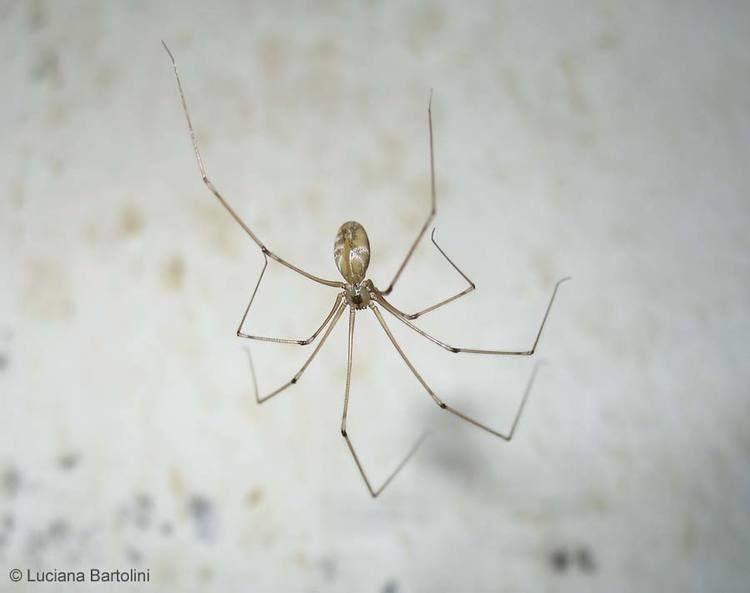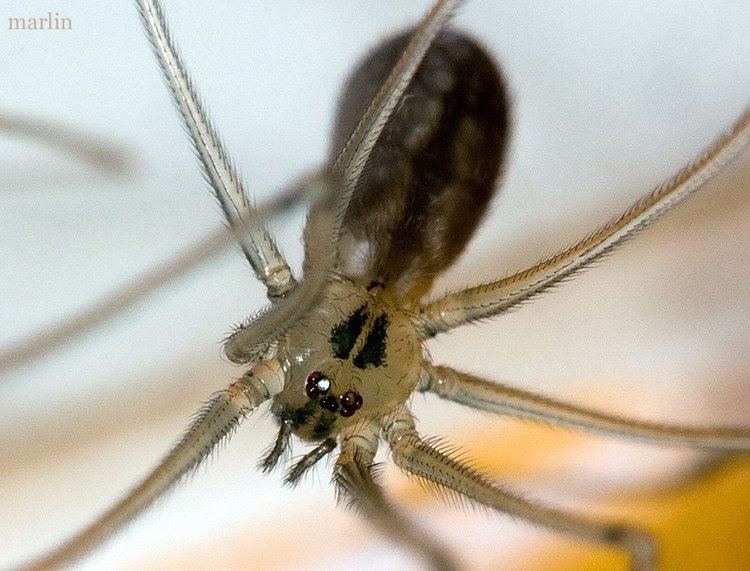Number of legs 8 Rank Family Higher classification Araneomorphae | Scientific name Pholcidae Order Spider | |
 | ||
Lower classifications | ||
Cellar spider pholcidae handling and information
Pholcidae, commonly known as cellar spiders, are a spider family in the suborder Araneomorphae. The family contains about 1500 species divided into about 80 genera.
Contents
- Cellar spider pholcidae handling and information
- Female cellar spider pholcidae with babies
- Appearance
- Habitat
- Trapping
- Threat response
- Diet
- Gait
- Systematics
- Misconceptions
- References

Some species, especially Pholcus phalangioides, are commonly called daddy long-legs spider, granddaddy long-legs spider, carpenter spider, daddy long-legger, or vibrating spider. Confusion often arises because the name "daddy long-legs" is also applied to two distantly related arthropod groups: the harvestmen (which are arachnids but not spiders), and crane flies (which are insects).

Female cellar spider pholcidae with babies
Appearance

Pholcids are fragile arachnids, the body being 2–10 mm in length with legs which may be up to 50 mm long. Pholcus and Smeringopus have cylindrical abdomens and the eyes are arranged in two lateral groups of three and two smaller median contiguous eyes. Eight and six eyes both occur in this family. Spermophora has a small globose abdomen and its eyes are arranged in two groups of three and no median eyes. Pholcids are gray to brown with banding or chevron markings. The shape of the Pholcus and Smeringopus's body resembles that of a peanut.
Habitat

Pholcids are found in every continent in the world except Antarctica where it is too cold for them to survive. They hang inverted in messy, irregular, tangled webs. These webs are constructed in dark and damp recesses, such as: caves, under rocks and loose bark, abandoned mammal burrows, and undisturbed areas in buildings, such as cellars (hence the common name "cellar spider"). However, Pholcids are also quite commonly found in warm, dry places, such as household windows and attics.
Trapping
The web has no adhesive properties but the irregular structure traps insects, making escape difficult. The spider quickly envelops its prey with silk and then inflicts the fatal bite. The prey may be eaten immediately or stored for later.
Threat response
When the arachnid is threatened by a touch to the web or when too large a prey becomes entangled, the arachnid vibrates rapidly in a gyrating motion in its web and becomes blurred and difficult to focus on. For this reason pholcids have sometimes been called "vibrating spiders", although they are not the only species to exhibit this behavior. Doing so might make it difficult for a predator to see exactly where the spider is, may be intended to signal an assumed rival to leave, or may increase the chances of capturing insects that have just brushed their web and are still hovering nearby. If the spider continues to be harassed it will retreat into a corner or drop from its web and escape.
Diet
Certain species of these seemingly benign spiders invade webs of other spiders and eat the host, the eggs or the prey. In some cases the spider vibrates the web of other spiders, mimicking the struggle of trapped prey to lure the host of the web closer. Pholcids are natural predators of the Tegenaria species, and are known to attack and eat redback spiders, huntsman spiders and house spiders. It is this competition that helps keep Tegenaria populations in check, which may be advantageous to humans who live in regions with dense hobo spider populations.
Gait
Pholcus phalangioides often uses an alternating tetrapod gait (first right leg, then second left leg, then third right leg, etc.), which is commonly found in many spider species. However, frequent variations from this pattern have been documented during observations of the spiders’ movements.
Systematics
As of November 2015, the World Spider Catalog accepts the following genera:
Misconceptions
There is a legend that daddy long-legs spiders have the most potent venom of any spider, but that their chelicerae (fangs) are either too small or too weak to puncture human skin; the same legend is also repeated of the harvestman and crane fly, also known as "daddy long-legs" in some regions. Indeed, pholcid spiders do have a short fang structure (called uncate due to its "hooked" shape). Brown recluse spiders also have uncate fang structure, but are able to deliver medically significant bites. Possible explanations include: pholcid venom is not toxic to humans; pholcid uncate are smaller than those of brown recluse; or there is a musculature difference between the two arachnids, with recluses, being hunting spiders, possessing stronger muscles for fang penetration.
During 2004, the Discovery Channel television show MythBusters tested the daddy long-legs venom myth in episode 13 - "Buried in concrete". Hosts Jamie Hyneman and Adam Savage first established that the spider's venom was not as toxic as other venoms, after being told about an experiment whereby mice were injected with venom from both a daddy long-legs and a black widow, with the black widow venom producing a much stronger reaction. After measuring the spider's fangs at approximately 0.25 mm (average human skin thickness varies from about 0.5 mm to 4 mm), Adam Savage inserted his hand into a container with several daddy-long-legs, and reported that he felt a bite which produced a mild, short-lived burning sensation. Due to the difference between the fang length and average human skin thickness, it is unlikely that a bite actually penetrated Savage's skin. If indeed Savage felt a bite, it would confirm that pholcids bites can penetrate human skin, but will deliver envenomation harmless to at least some humans. Additionally, recent research by Alan Van Dyke has shown that pholcid venom is relatively weak in its effects on insects.
According to Rick Vetter of the University of California at Riverside, the daddy long-legs spider has never harmed a human and there is no evidence that they are dangerous to humans.
The legend may result from the fact that the daddy long-legs spider preys upon deadly venomous spiders, such as the redback, a member of the black widow genus Latrodectus. To the extent that such entomological information was known to the general public, it was perhaps thought that if the daddy long-legs spider could kill a spider capable of delivering fatal bites to humans, then it must be more venomous, and the uncate fangs were regarded as prohibiting it from killing people. In reality, it is able to cast lengths of silk onto its prey, incapacitating them from a safe distance. However, the legend may simply be a type of "thrill" story about an ordinary, familiar object alleged to represent something dangerous or dramatic, combined with a superficially plausible reason why the danger is not observed in practice, perhaps suggested by the fact that the animal's legs—its most striking observable feature—are so long that they would seem (if vertical) to prevent its mouth from getting close to whatever it walks upon.
